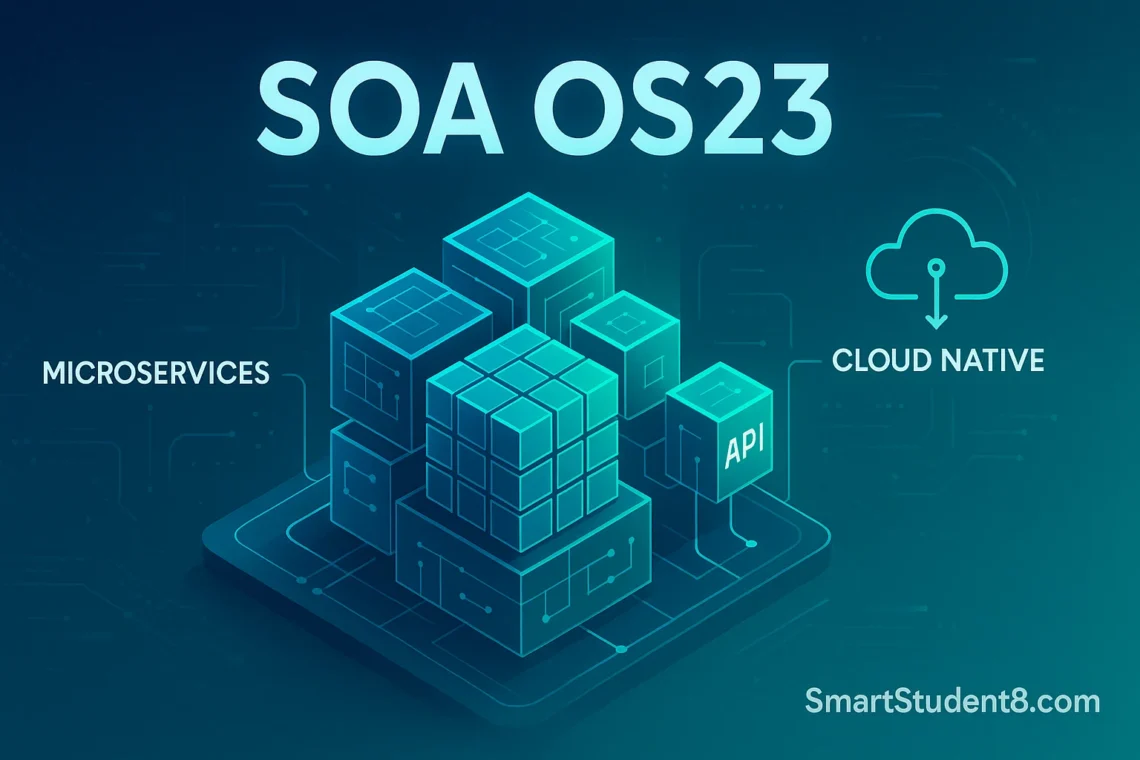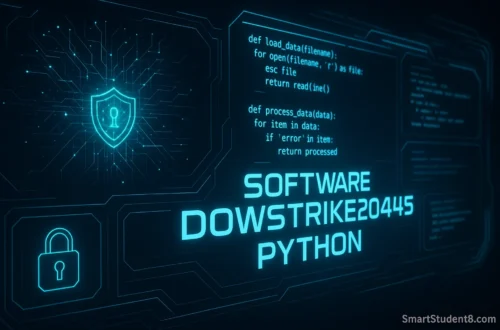In the world of software, there is constant evolution. Businesses must adopt the latest architectural styles to remain efficient and competitive. SOA OS23 has been one of the major shifts over the last few years. The SOA OS23 is not just another tech term; it’s a paradigm shift for how complex software systems are designed, built, and managed. Imagine an environment where all your digital tools could communicate, collaborate, and grow with you. SOA OS23 is a promise to deliver on.
In my career as a software architecture, I’ve witnessed many frameworks. Some of them were revolutions, and others were temporary fads. The principles of SOA OS23 were different when I first heard them. The transition felt natural, and it was a necessary one. It solved many problems that businesses and developers have been facing for years due to monolithic inflexible systems. In this article, you will learn what SOA OS23 really is, the way it functions, and its transformative effect across various industries. Its core features and real-world uses will be explored, as well as why SOA OS23 is fast becoming the standard for future-proof digital platforms.
Understanding SOA OS23: A Modern Approach
SOA OS23, at its heart, stands for the “Service-Oriented Architecture Open Standard 23.” The framework is an innovative software development tool that incorporates service-oriented principles into operating systems. SOA OS23 advocates the use of small and independent services, rather than building large single-unit apps with all components tightly connected. Each service has been designed to fulfill a certain business function like user authentication, data analytics, payment processing. The services can work independently and are not “loosely” coupled.
This style of architecture is quite different from other architectural styles. It’s like carving a sculpture from one block of rock instead of using LEGO bricks. The LEGO method allows you to add, delete, or modify individual bricks while not affecting the whole structure. The modularity of SOAOS23 is essential to its flexibility and robustness. The framework supports the use of standard interfaces and communication protocols to allow these different services interact smoothly and exchange data. The focus on interoperability helps to break down the technology silos which often hinder growth in larger organisations.
This is how SOA OS23 works: the core mechanics
It is important to fully grasp SOA OS23’s power by understanding the mechanics behind its operation. It relies on a number of key concepts which work in tandem to produce a dynamic, efficient ecosystem. The framework is more than a theory, it’s a guide to building maintainable and scalable systems. I have found that when components are combined, they create a much more complex system than their individual parts. It is built to be responsive, intelligent, and robust.
Microservices and API Centric Communication
SOA OS23 relies on microservices as its foundation. This technique breaks up large applications into more manageable and smaller services. The microservices each handle a specific piece of functionality. They can also be scaled, developed and deployed independently. You might, for example, have different microservices to handle the product catalogue, shopping cart and customer reviews in an ecommerce system. This allows the different teams of developers to be working on various services simultaneously.
Application Programming Interfaces, or APIs, are the means of communication between these services. APIs serve as messengers and define clear protocols that govern how services interact. APIs are used to ensure that all services communicate well, no matter what programming language or technology they use. The API-centric approach ensures that services can communicate effectively, even if they are built using different programming languages or technologies. The advantage is huge over old systems that could be ruined by a simple update.
SOA OS23: Key Benefits
SOA OS23 offers a number of benefits which address some of the most important challenges in modern software development. These benefits are not theoretical. They translate into improvements in cost-effectiveness, efficiency and agility. Businesses will gain a more competitive edge, and be able to adapt faster to changing market conditions. It means less frustration and a better workflow for developers.
Some of the most important benefits are:
- Improved Scalability: The inherent ability to scale is one of the most impressive features. You can increase the scale of individual services as your business grows. When your holiday sales are high, and you have a lot of traffic on the payment processing service, it’s possible to allocate additional resources for that service. Using this granular level of control, you can ensure optimal performance as well as efficient resource utilization.
- Increased Agility and Flexibility: SOA’s OS23 is modular, providing unmatched flexibility. Addition of new services and modification of existing services allows businesses to quickly respond to changing market conditions or requirements. It allows for a faster time to market of new features.
- Improved Resilence and Fault isolation: With a monolithic architectural design, one failure could bring the system to a halt. SOA OS23 isolates the failure of a service and does not impact other services. This fault separation improves application uptime, reliability and overall performance.
Reusing services between different applications can help businesses reduce costs for development and maintainance. Cost efficiency combined with better collaboration among teams who are working on standardized user interfaces can create a powerful engine of sustainable growth.
SOA OS23 Vs. Monolithic Traditional Architecture
In order to fully understand SOA OS23, we can compare its revolutionary features with those of the old monolithic architectural style that has dominated software design for years. I began my career developing monolithic applications. They were functional, but their limits became apparent when business needs became complexer and more dynamic. SOA OS23, the result of this evolution to a services-oriented paradigm was an important step forward.
The monolithic app is created as one unit. Its functions and parts are tightly linked and operate as a single unit. Although this method is easier to implement and create initially, the complexity increases as the application grows. This comparison highlights fundamental differences, and explains why so many organisations are moving to the new approach.
| The Feature | Monolithic Structure | SOA OS23 Architecture |
|---|---|---|
| Structure | Codebase based on a large single codebase. | A collection of independent small services. |
| Delivery | If you make a change, the application needs to be redeployed. | The individual services can be used independently, without any interruption. |
| Scalability | The entire application must be scaled, and this is inefficient. | Can optimize resource utilization by scaling specific services in response to the demand. |
| Technology Stack | One technology stack is used for all applications. | Each service is built using the most appropriate technology. |
| Fault Tolerance | The entire system can be affected by a failure of a single component. | A service failure is not a problem for other services. |
| Developer | The codebase becomes more complicated and slow as it grows. | Faster development cycle as multiple teams are able to work together on the same service. |
| Flexibility | Very rigid. Changes are risky and difficult to implement. | High flexibility; easily add or update services. |
This table shows a paradigm shift. Although monolithic system initially offered simplicity, SOA OS23 delivers the flexibility, scalability and resilience needed for long-term success in today’s digital environment.
Digital Transformation and its Transformative role
SOA OS23 goes beyond an architectural style; it is also a powerful tool for digital transformation. Business leaders in all industries are under increasing pressure to upgrade their business operations, improve customer service, and better leverage data. This framework is the basis for these goals. Breaking down legacy rigid systems and transforming them into flexible services ecosystems allows organizations to unlock higher levels of innovation. Adopting these principles has allowed companies that were struggling with outdated technologies to completely revamp their operations.
This architecture allows seamless integration of emerging technologies, such as AI and IoT. Businesses don’t have to try and force new technologies into an inflexible, old system. They can instead build them or integrate as new services which communicate with the current ecosystem. Modularity allows modernization to be done gradually, which reduces risk and costs. The modular approach allows businesses to develop interconnected digital environments, in which data is freely shared between departments or even external partners. It fosters collaboration and creates new value streams.
Real-World Applications Across Industries
SOA OS23’s versatility makes it suitable for a broad range of industries. Each has its own set of challenges and unique requirements. Modern enterprises value its ability to efficiently and securely manage distributed, complex systems. It is clear that this architecture has a real impact when you look at different industries and how they use it to solve practical issues and promote innovation.
A few notable examples include:
- Medical: Hospitals, clinics use SOA OS23 in order to build integrated platforms for healthcare. Patient records, appointment schedules, and laboratory results are all able to communicate in a secure manner, so that doctors can have an overview of their patient’s entire health record. The system improves the diagnostic process, minimizes mistakes, and allows for compliance with HIPAA’s strict privacy rules.
- Finance & Banking: SOA OS23 is used by the financial industry to create robust, secure and reliable systems, from mobile bank to fraud detection. Microservices such as those for KYC compliance, risk assessment and transaction processing can all be individually updated in response to security threats and new regulations.
- Online and Retail E-commerce: The architecture allows retailers to handle complex tasks like supply chain management and logistics as well as personalized customer experience. One service can be used to communicate between a point of sale system and another service which handles online orders.
These examples show SOA OS23’s benefits are not limited to technology companies. This tool is powerful for any organisation looking to build an agile, responsive and interconnected digital architecture that can meet the challenges of tomorrow.
Navigating Implementation’s Challenges
Transitioning from SOA OS23 to SOA OS23 does not come without challenges. The adoption of this new architecture involves careful planning, an investment in skills and tools, and a new mindset. In my experience of guiding teams during this transition, I have found that cultural barriers are more common than technical ones. The employees can resist the change. Moving from a monolithic workflow into a service-oriented, distributed one is daunting.
Initial complexity and initial investment are the two biggest obstacles. A microservices eco-system that is properly orchestrated, monitored, and secure requires significant effort upfront. A common challenge is the management of distributed systems. It can be much more complicated to debug a system that has multiple services than it is troubleshooting one application. Organisations must establish good governance to prevent “microserviceanarchy”, where teams build redundant and inconsistent services. In order to overcome these obstacles, organizations need strong leadership as well as a vision and commitment towards training and continual improvement.
What are the best practices for an adoption that is successful?
Organizations should use a list of proven best practices to ensure the smooth and successful deployment of SOA OS23. An approach that is strategic can mitigate challenges, and maximise the return on your investment. This guide can be used as a road map to assist in the journey toward a service oriented architecture.
Starting with a thorough audit and clear vision of the existing system is a good place to start. Define measurable objectives for the architecture you are aiming to create. You should invest in training your team to ensure that they have the required skills for microservices design, API development, and containerization. It’s also crucial to adopt modern tools for orchestration, monitoring, and continuous integration/continuous deployment (CI/CD) to automate processes and improve efficiency. In addition, encourage a culture where communication and collaboration are encouraged across teams. Adopting SOAOS23 successfully is a collaborative effort that demands alignment and support from all stakeholders.
Future of SOA OS23 System Design
SOA OS23 has a bright future. It is constantly evolving due to community input and technological advancements. AI-driven systems that automate predictive maintenance and intelligent resource allocating will become more integrated with AI. The result will be self-healing, self-optimizing system that requires minimal human involvement.
In the future, as the Internet of Things and edge computing will become more commonplace, SOA OS23’s lightweight and modular structure makes it the ideal solution for the deployment of services in devices with limited resources at the edge of the network. The processing of data will be closer to the source, allowing for more responsive and faster applications. As this standard is continually developed, it ensures its place at the forefront for innovation and provides the foundation of the next generation digital services.
Read More: NS Mainframe : The Unseen Engine of Modern Enterprise
Conclusion: The Next Era of Architecture
SOA OS23 marks a significant evolution in the software architecture. Because, it focuses on modularity, scaling, and seamless integration. It’s a great solution for the complexity that modern digital environments present. Organizations can create infrastructures more flexible and adaptable by moving away rigid, monolithic services and towards a flexible, independent ecosystem. It takes a lot of planning to adopt the technology, and it requires a culture shift. But in the end, you will reap many benefits – from faster innovation to improved customer experience.
The impact of this architecture philosophy is still just starting to be felt. The principles of SOA OS23 are no longer an optional choice for developers or businesses who want to build future-proof, robust systems. They’re a must. The blueprint is for the digital world that will be dynamic, intelligent and connected in the future.





